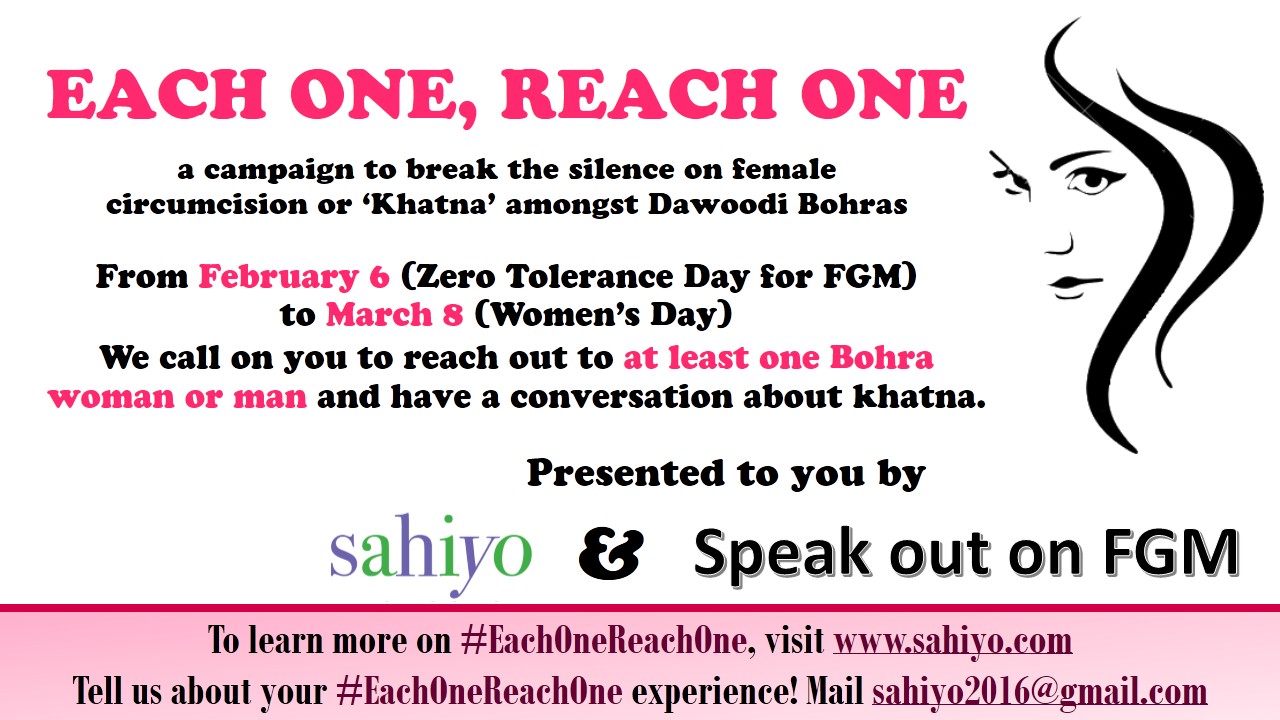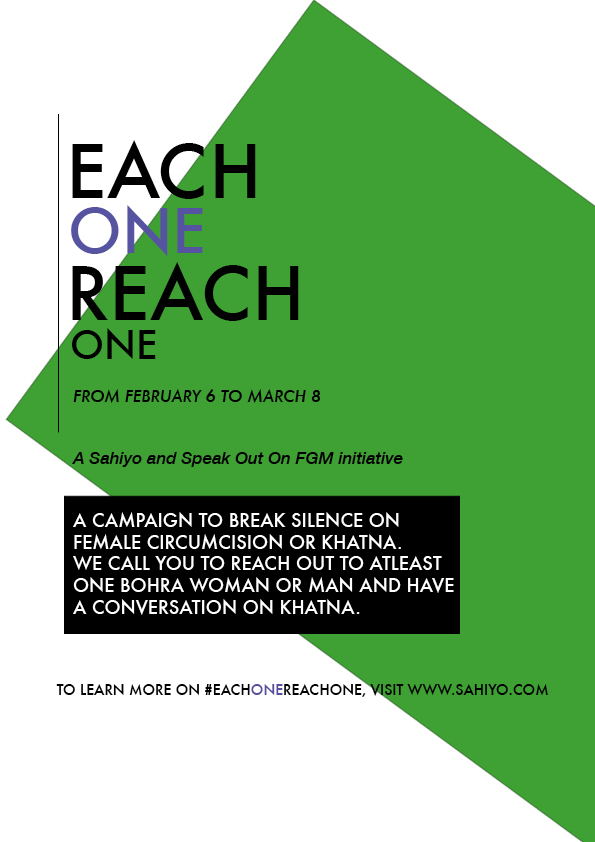Each One, Reach One
A campaign to raise awareness about female genital cutting among Bohras
by Sahiyo and Speak Out on FGM
February 6 – March 8, 2016
The Bohras are the only known community in India to practice female circumcision, a ritual that involves cutting the tip of a young girl’s clitoris. The practice is also called female genital cutting, female genital mutilation, or khatna, and it is regarded as a violation of human and child rights by the World Health Organisation.
For far too long, Bohras have continued this practice in silence and secrecy, making it almost impossible for girls and women to talk about the many ways in which khatna has affected them – physically, psychologically, emotionally and sexually.
Let us break the silence now.
February 6 has been declared the International Day of Zero Tolerance for Female Genital Mutilation. On this day, we shall launch ‘Each One Reach One’, a campaign that aims to erase the secrecy around female circumcision and generate a healthy dialogue about it. This month-long campaign will extend up to March 8, which is celebrated as International Women’s Day.
Here is how you can participate in ‘Each One Reach One’:
- Between February 6 and March 8, reach out to at least one Bohra woman you know and have a conversation about khatna/female circumcision. Encourage each person you have spoken with to reach out to at least one other Bohra. A face-to-face conversation is ideal, but it can also be done digitally.
- If the conversation is digital, take a look at the social media messages we have created and see if you feel comfortable sharing one of the messages with your friends and relatives through Facebook, Twitter, Whatsapp, or any other communication platform that you use. Check in with friends and family to see if they would be comfortable continuing the dialogue by sharing these messages with their own networks.
- During your conversation, share stories about khatna: memories of the day when the cut was done, feelings and emotions towards the experience, the reasons given for the practice, the reasons behind the silence around the practice, the physical, psychological and sexual impact of the practice for women.
- Keep the conversation healthy, friendly and respectful, rather than judgmental, moralistic or aggressive. Read more about this in our brochure on “How to Have a Healthy Dialogue on Khatna”.
- Speak to Bohra men too! This campaign is not restricted to the ladies. Silence can only be broken when men and women speak together – and to each other.
- The campaign is not only for Indians – we call upon Bohras all over the world to reach out to one another.
- Tell us about your participation. If you feel comfortable, tell us about the experience of sharing stories with other women (and men). Was it an emotional experience? Did you learn something you didn’t know before? Did you make a new friend? Mail us at This email address is being protected from spambots. You need JavaScript enabled to view it. and rest assured that your identity will remain private.
For more information, check out the following documents:
- Each One, Reach One Press Release
- Each One, Reach One Social Media Messages
- Each One, Reach One Helpful Dialogue Guidelines
- Each One, Reach One Posters 1, 2, 3.

What is Female Genital Cutting?
Female Genital Cutting (FGC) or Female Genital Mutilation (FGM) is the practice of removing parts of a woman’s external genitalia for various ritualistic purposes. This could range from cutting the tip of the clitoris to removing the inner and outer labia, and in some communities, stitching the labia closed. Depending on the severity of the cutting, FGC can have a range of adverse health consequences for women, in addition to psychological trauma.
The exact origins of the practice are not known, but it is widely believed that FGC originated in Eastern Africa, and predates the beginning of Christianity. Today, various types of FGC are known to be practiced in a large number of African countries, in many Gulf/Arab countries and Asian countries like Malaysia, Indonesia and to a small extent in Pakistan and India.
FGC is considered a human rights violation by the World Health Organisation and has been outlawed by several countries around the world.
Who are the Bohras?
The Bohras are a sect of Shia Islam, of which the Dawoodi Bohras are the largest sub-sect. The community has a population of 1.5 to 2 million, of which around half live in India, while the rest have settled all over the world. The Bohras are the only community known to practice female genital cutting in India.
The ritual is referred to as Khatna or female circumcision, and involves cutting the tip of a girl’s clitoris when she is 6-7 years old. The most common reason the community members give for practicing khatna is that it moderates a woman’s sexual urges and prevents her from becoming promiscuous.
About Sahiyo
Sahiyo is a pioneering organization founded last year by five women who feel strongly about the practice of khatna in the Bohra community. Sahiyo is the Bohra Gujarati word for ‘saheliyo’, or friends, and reflects our organization’s mission to engage in dialogue with the community to find a collective solution towards ending the practice. Sahiyo is completing the first large-scale online survey about the way FGC is practiced among the Bohras. To learn more about Sahiyo, visit:
- Website: sahiyo.org
- Facebook: www.facebook.com/SahiyoVoices
- Twitter: https://twitter.com/sahiyovoices
About Speak Out on FGM
Speak Out on FGM is a forum of several Bohra women who came together last year to spread awareness about and fight the practice of khatna in the community. Last December, Speak Out launched an online petition asking the Indian government to stop FGC in India, and the petition has received more than 42,000 signatures so far.

